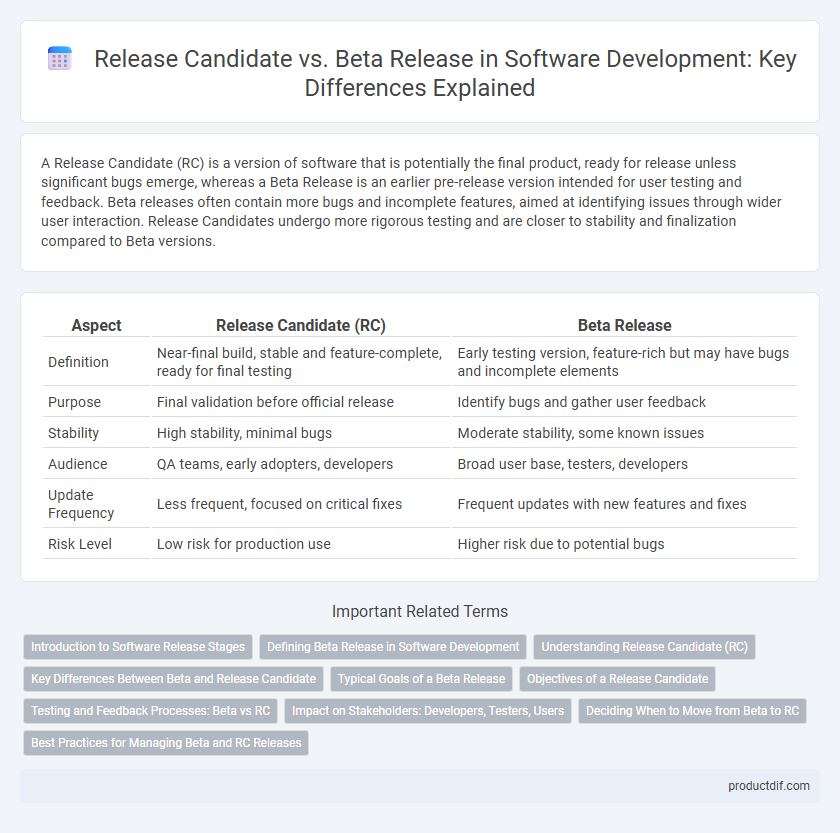A Release Candidate (RC) is a version of software that is potentially the final product, ready for release unless significant bugs emerge, whereas a Beta Release is an earlier pre-release version intended for user testing and feedback. Beta releases often contain more bugs and incomplete features, aimed at identifying issues through wider user interaction. Release Candidates undergo more rigorous testing and are closer to stability and finalization compared to Beta versions.
Table of Comparison
| Aspect | Release Candidate (RC) | Beta Release |
|---|---|---|
| Definition | Near-final build, stable and feature-complete, ready for final testing | Early testing version, feature-rich but may have bugs and incomplete elements |
| Purpose | Final validation before official release | Identify bugs and gather user feedback |
| Stability | High stability, minimal bugs | Moderate stability, some known issues |
| Audience | QA teams, early adopters, developers | Broad user base, testers, developers |
| Update Frequency | Less frequent, focused on critical fixes | Frequent updates with new features and fixes |
| Risk Level | Low risk for production use | Higher risk due to potential bugs |
Introduction to Software Release Stages
Release Candidate (RC) and Beta Release are crucial stages in the software development lifecycle, representing near-final and testing phases, respectively. Beta Releases are early versions shared with a wider audience to identify bugs and gather user feedback, while Release Candidates are more polished versions pending final approval before official launch. Understanding these stages helps in managing expectations and improving software quality through iterative testing.
Defining Beta Release in Software Development
A Beta Release in software development is a pre-release version made available to a limited user base for testing under real-world conditions. It aims to identify bugs, gather user feedback, and validate functionality before the final release. Beta versions often precede the Release Candidate stage, where the software is more stable and closer to the finished product.
Understanding Release Candidate (RC)
A Release Candidate (RC) is a software version that is potentially the final product unless significant bugs emerge, indicating readiness for public release. It undergoes thorough testing to ensure stability, functionality, and performance align with project specifications. Unlike Beta releases, which are primarily for identifying bugs and collecting user feedback, RCs emphasize final validation before official launch.
Key Differences Between Beta and Release Candidate
Beta releases are early software versions distributed to a broader user base for testing and feedback, often containing incomplete features and known bugs. Release candidates represent a more polished stage, with all features implemented and only minor issues remaining before the final release. The key difference lies in stability and readiness: beta versions emphasize feature validation, while release candidates focus on final bug fixes and performance optimization.
Typical Goals of a Beta Release
A Beta Release aims to identify bugs and gather user feedback through real-world testing, enabling developers to refine features, improve usability, and ensure stability before the final product launch. It typically involves a larger user base than alpha versions, focusing on performance evaluation and compatibility across diverse environments. Beta testing helps verify functionality adherence to requirements while uncovering unforeseen issues in varied usage scenarios.
Objectives of a Release Candidate
A Release Candidate (RC) serves as the final testing phase before official software launch, aiming to identify critical bugs that could hinder user experience or system stability. Its objective is to ensure the software meets all functional requirements and quality standards, reflecting a product nearly identical to the final version. Unlike Beta releases, which gather broad user feedback, Release Candidates concentrate on validation and polishing, confirming readiness for production deployment.
Testing and Feedback Processes: Beta vs RC
Beta releases enable broader user testing and feedback collection, exposing the software to real-world scenarios and diverse environments. Release candidates undergo more controlled testing with a focus on bug fixing and feature stability, incorporating feedback primarily from internal testers and key stakeholders. The beta phase identifies usability issues and gathers user experience data, while the release candidate phase ensures readiness for final deployment through rigorous validation.
Impact on Stakeholders: Developers, Testers, Users
Release Candidate versions signal near-final software with critical bugs addressed, enabling developers to focus on polishing features and ensuring stability, while testers perform final validation under real-world conditions, and users provide feedback on usability and remaining issues. Beta Releases offer early access to new features and functionality, encouraging testers to identify bugs and suggest improvements, and users to explore capabilities with potential instability risks. The impact on stakeholders varies as Release Candidates prioritize quality assurance and readiness for launch, whereas Beta versions emphasize feature evaluation and iterative refinement.
Deciding When to Move from Beta to RC
A Beta release is designed for broader user testing to identify bugs and gather feedback, while a Release Candidate (RC) is a near-final version intended for final validation before the official launch. Moving from Beta to RC requires ensuring critical issues are resolved, feature completeness is achieved, and stability benchmarks meet predefined quality standards. Data-driven decision-making involves analyzing user feedback, crash reports, and performance metrics to confirm readiness for the RC phase.
Best Practices for Managing Beta and RC Releases
Effective management of Beta and Release Candidate (RC) phases involves structured feedback collection, rigorous testing, and clear communication with stakeholders to ensure software stability and usability. Beta releases should prioritize broad user engagement to identify potential bugs and usability issues, while RC releases focus on final validation and critical bug fixes before launch. Implementing automated testing, maintaining detailed release notes, and scheduling incremental updates enhances the transition from Beta to RC, ultimately improving product quality and deployment confidence.
Release Candidate vs Beta Release Infographic

 productdif.com
productdif.com